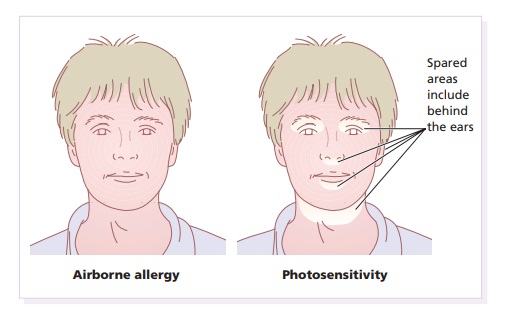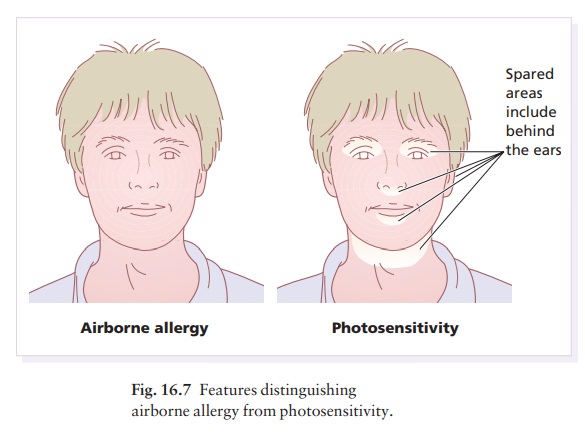Chapter: Clinical Dermatology: Skin reactions to light
Chronic actinic dermatitis (actinic reticuloid)

Chronic
actinic dermatitis (actinic reticuloid)
Some
patients with a photoallergic reaction never get over it and go on developing
sun-induced eczematous areas long after the drug has been stopped.
Cause
This
is not clear but some believe minute amounts of the drug persist in the skin
indefinitely.
Presentation
This
is the same as a photoallergic reaction to a drug. The patient goes on to
develop a chronic dermatitis, with thick plaques on sun-exposed areas.
Course
These
patients may be exquisitely sensitive to UVR. They are usually middle-aged or
elderly men who react after the slightest exposure, even through window glass
or from fluorescent lights. Affected individuals also become allergic to a
range of contact allergens, espe-cially oleoresins in some plants (e.g.
chrysanthemums).
Complications
None,
but the persistent severe pruritic eruption can lead to depression and even
suicide.
Differential diagnosis
Airborne
allergic contact dermatitis may be confused, but does not require sunlight.
Sometimes the dia-gnosis is difficult as exposure both to sunlight and to the
airborne allergen occurs only out of doors. Air-borne allergic contact
dermatitis also affects sites which sunlight is less likely to reach, such as
under the chin (Fig. 16.7). A continuing drug photoallergy, a poly-morphic light
eruption or eczema as a result of some
other cause must also be considered.

Histology
shows a dense lymphocytic infiltrate and sometimes atypical lymphocytes
suggestive of a lym-phoma, but the disorder seldom becomes malignant.
Investigations
Persistent
light reaction can be confirmed experiment-ally by exposing uninvolved skin to
UVA or UVB. Patch tests and photopatch tests help to distinguish between
photoallergy and airborne allergic contact dermatitis, and the action spectrum
may point to a certain drug. This sort of testing is difficult, and should be
carried out only in specialist centres.
Treatment
Usually cared for by specialists, these patients need extreme measures to protect their skin from UVR. These include protective clothing and frequent applica-tions of combined UVA and UVB blocking agents (Formulary 1). Patients must protect them-selves from UVR coming through windows or from fluorescent lights. Some can only go out at night. As even the most potent topical steroids are often ineffective, systemic steroids or immunosuppressants (e.g. azathioprine) may be needed for long periods.
Related Topics